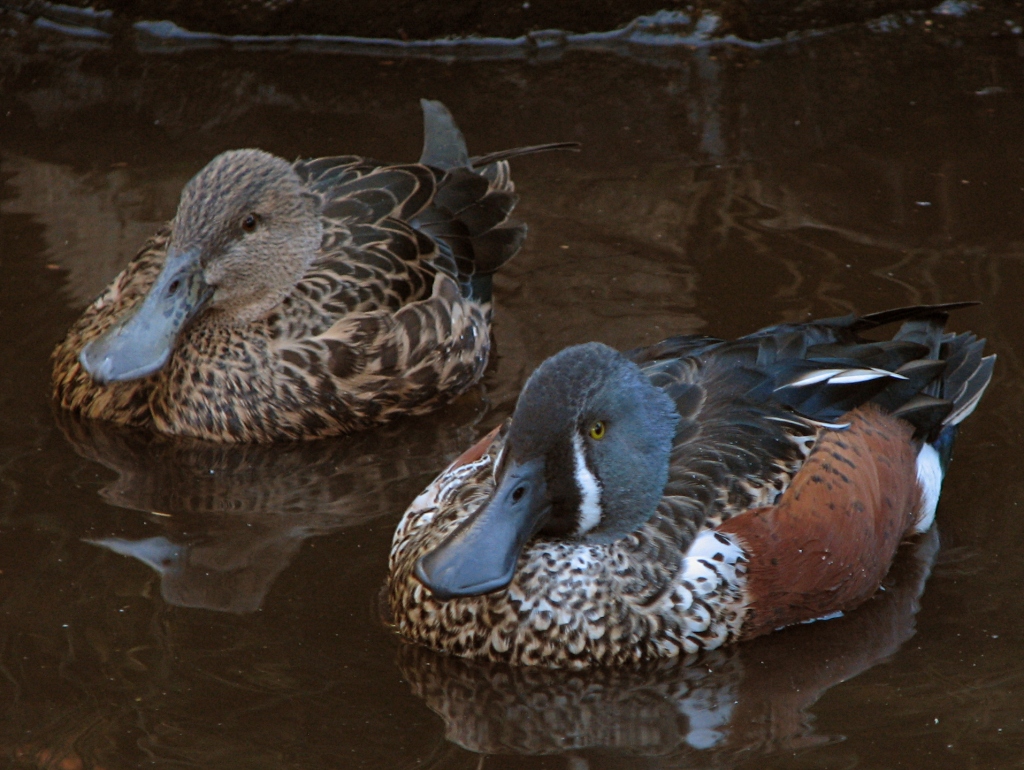
Australasian shoveler(Anas rhynchotis)
Phylum —chordata
Class — aves
Order — anseriformes
Family — anatidae
Genus –anas
Appearance
The Australasian shoveler is a low-floating, dark headed duck, with a low sloping forehead blending to a heavy, square-cut, shovel-tipped bill. The male in breeding plumage has a deep grey-blue head with a vertical white crescent between the bright-yellow eye and the bill The back and rump are black, and the shoulder and wing coverts are blue-grey with several white bars. The underparts are chestnut, with white patches to the rear of the flanks. Outside the breeding season, the males are much duller. Females have mottled brown upperparts, chestnut underparts, and a dark brown eye.
It ranges from 46 to 53 cm.
Habitat
Australasian shovelers are widespread throughout the North and South Islands in New Zealand, rarely on Stewart Island.
Behavior
The Australasian shoveler is a highly mobile species with many birds probably traversing the length of New Zealand annually before returning again to their breeding areas.
Like other shoveler species, Australasian shovelers moult communally in large numbers at very few places and generally occur in flocks for most of the year.
Diet
Australasian shovelers feed mostly by filtering surface water or mud through their bill lamellae. They occasionally will upend to feed on the wetland floor. A wide range of small freshwater mollusks, crustaceans and insects are taken and small seeds of many aquatic plants also.
Reproduction
The Australasian shoveler breeds at almost any time in the arid parts of the continent, synchronized with flooding rains. Nests are built on the ground in dense vegetation, sometimes on a stump or hollow of a tree that is standing in water. The female alone incubates the eggs and broods the young.
In captivity
Lifespan in captivity is up to 30 years.
It is not difficult to keep shovelers. In summer, they are kept in outdoor enclosures. The minimum size of the enclosure is 4 square meters.
In winter, they should be transferred to an insulated enclosure with a temperature of at least +5 °C. However, Australasian shovelers can easily live at cold temperatures (up to -7 °C), and in areas where winter temperatures do not fall below -8 °C, they can be kept outdoors all year round. It is desirable to equip the enclosure with additives in the form of branches and perches. In the winter room, you must install a pool with running or frequently replaced water. In areas with mild winters, shovelerscan be kept in outdoor enclosures.
In this case, all winter it is necessary to maintain a sufficient mirror of the reservoir for birds, not covered with ice. This is achieved in various ways, one of which may be the use of an air compressor. Long hoses from the compressor that pumps air are lowered to the bottom of the reservoir, and air bubbles, rising up, carry warmer water. With constant mixing of warm water from the lower layers of the reservoir with colder water from the surface, the possibility of ice formation is eliminated even in the most severe frosts.
As a winter bedding for waterfowl, you can use soft hay, which is laid out in places where birds rest.
The diet includes grain feed-corn, wheat, barley, millet, oatmeal, wheat bran, grass, meat and fish meal, chalk, small shell, gammarus. In the warm season, it is good to give various greens - cut dandelion leaves, lettuce, plantain, duckweed. Good food for ducks - wet mixture of grated carrots, bran, various cereals. During the reproductive period and during molting, they are mixed with wet food or given separately: fish and minced meat. The diet should be with the proportion of organic and vegetable feed 1/1.
Shovelersare friendly to other birds, so they can be kept on the same pond with other ducks.
Artificial shelters for nests are installed in the paddock. Ducks independently incubate, breed and raise ducklings.
 Russian
Russian
 English
English
























